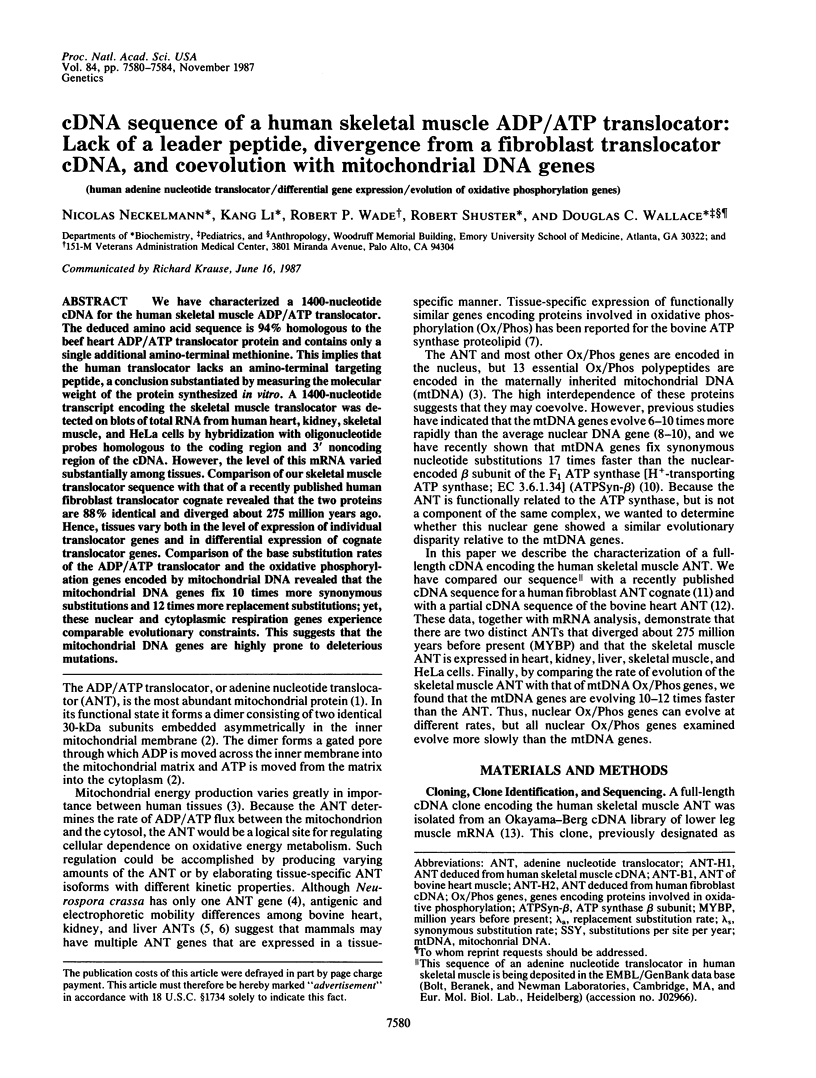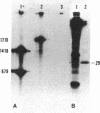Abstract
We have characterized a 1400-nucleotide cDNA for the human skeletal muscle ADP/ATP translocator. The deduced amino acid sequence is 94% homologous to the beef heart ADP/ATP translocator protein and contains only a single additional amino-terminal methionine. This implies that the human translocator lacks an amino-terminal targeting peptide, a conclusion substantiated by measuring the molecular weight of the protein synthesized in vitro. A 1400-nucleotide transcript encoding the skeletal muscle translocator was detected on blots of total RNA from human heart, kidney, skeletal muscle, and HeLa cells by hybridization with oligonucleotide probes homologous to the coding region and 3' noncoding region of the cDNA. However, the level of this mRNA varied substantially among tissues. Comparison of our skeletal muscle translocator sequence with that of a recently published human fibroblast translocator cognate revealed that the two proteins are 88% identical and diverged about 275 million years ago. Hence, tissues vary both in the level of expression of individual translocator genes and in differential expression of cognate translocator genes. Comparison of the base substitution rates of the ADP/ATP translocator and the oxidative phosphorylation genes encoded by mitochondrial DNA revealed that the mitochondrial DNA genes fix 10 times more synonymous substitutions and 12 times more replacement substitutions; yet, these nuclear and cytoplasmic respiration genes experience comparable evolutionary constraints. This suggests that the mitochondrial DNA genes are highly prone to deleterious mutations.
Full text
PDF




Images in this article
Selected References
These references are in PubMed. This may not be the complete list of references from this article.
- Adrian G. S., McCammon M. T., Montgomery D. L., Douglas M. G. Sequences required for delivery and localization of the ADP/ATP translocator to the mitochondrial inner membrane. Mol Cell Biol. 1986 Feb;6(2):626–634. doi: 10.1128/mcb.6.2.626. [DOI] [PMC free article] [PubMed] [Google Scholar]
- Aquila H., Misra D., Eulitz M., Klingenberg M. Complete amino acid sequence of the ADP/ATP carrier from beef heart mitochondria. Hoppe Seylers Z Physiol Chem. 1982 Mar;363(3):345–349. [PubMed] [Google Scholar]
- Arends H., Sebald W. Nucleotide sequence of the cloned mRNA and gene of the ADP/ATP carrier from Neurospora crassa. EMBO J. 1984 Feb;3(2):377–382. doi: 10.1002/j.1460-2075.1984.tb01815.x. [DOI] [PMC free article] [PubMed] [Google Scholar]
- Arnheim N. Characterization of mouse ribosomal gene fragments purified by molecular cloning. Gene. 1979 Oct;7(2):83–96. doi: 10.1016/0378-1119(79)90025-8. [DOI] [PubMed] [Google Scholar]
- Baker A., Leaver C. J. Isolation and sequence analysis of a cDNA encoding the ATP/ADP translocator of Zea mays L. Nucleic Acids Res. 1985 Aug 26;13(16):5857–5867. doi: 10.1093/nar/13.16.5857. [DOI] [PMC free article] [PubMed] [Google Scholar]
- Battini R., Ferrari S., Kaczmarek L., Calabretta B., Chen S. T., Baserga R. Molecular cloning of a cDNA for a human ADP/ATP carrier which is growth-regulated. J Biol Chem. 1987 Mar 25;262(9):4355–4359. [PubMed] [Google Scholar]
- Bouillaud F., Weissenbach J., Ricquier D. Complete cDNA-derived amino acid sequence of rat brown fat uncoupling protein. J Biol Chem. 1986 Feb 5;261(4):1487–1490. [PubMed] [Google Scholar]
- Brown W. M., George M., Jr, Wilson A. C. Rapid evolution of animal mitochondrial DNA. Proc Natl Acad Sci U S A. 1979 Apr;76(4):1967–1971. doi: 10.1073/pnas.76.4.1967. [DOI] [PMC free article] [PubMed] [Google Scholar]
- Chirgwin J. M., Przybyla A. E., MacDonald R. J., Rutter W. J. Isolation of biologically active ribonucleic acid from sources enriched in ribonuclease. Biochemistry. 1979 Nov 27;18(24):5294–5299. doi: 10.1021/bi00591a005. [DOI] [PubMed] [Google Scholar]
- Douglas M. G., McCammon M. T., Vassarotti A. Targeting proteins into mitochondria. Microbiol Rev. 1986 Jun;50(2):166–178. doi: 10.1128/mr.50.2.166-178.1986. [DOI] [PMC free article] [PubMed] [Google Scholar]
- Feinberg A. P., Vogelstein B. "A technique for radiolabeling DNA restriction endonuclease fragments to high specific activity". Addendum. Anal Biochem. 1984 Feb;137(1):266–267. doi: 10.1016/0003-2697(84)90381-6. [DOI] [PubMed] [Google Scholar]
- Garrison J. C., Hardeman E., Wade R., Kedes L., Gunning P. Isolation of full-length cDNAs encoding abundant adult human skeletal muscle mRNAs. Gene. 1985;38(1-3):177–188. doi: 10.1016/0378-1119(85)90216-1. [DOI] [PubMed] [Google Scholar]
- Gay N. J., Walker J. E. Two genes encoding the bovine mitochondrial ATP synthase proteolipid specify precursors with different import sequences and are expressed in a tissue-specific manner. EMBO J. 1985 Dec 16;4(13A):3519–3524. doi: 10.1002/j.1460-2075.1985.tb04111.x. [DOI] [PMC free article] [PubMed] [Google Scholar]
- Gunning P., Ponte P., Okayama H., Engel J., Blau H., Kedes L. Isolation and characterization of full-length cDNA clones for human alpha-, beta-, and gamma-actin mRNAs: skeletal but not cytoplasmic actins have an amino-terminal cysteine that is subsequently removed. Mol Cell Biol. 1983 May;3(5):787–795. doi: 10.1128/mcb.3.5.787. [DOI] [PMC free article] [PubMed] [Google Scholar]
- Hennig B., Neupert W. Assembly of cytochrome c. Apocytochrome c is bound to specific sites on mitochondria before its conversion to holocytochrome c. Eur J Biochem. 1981 Dec;121(1):203–212. doi: 10.1111/j.1432-1033.1981.tb06450.x. [DOI] [PubMed] [Google Scholar]
- Klingenberg M. Membrane protein oligomeric structure and transport function. Nature. 1981 Apr 9;290(5806):449–454. doi: 10.1038/290449a0. [DOI] [PubMed] [Google Scholar]
- Laemmli U. K. Cleavage of structural proteins during the assembly of the head of bacteriophage T4. Nature. 1970 Aug 15;227(5259):680–685. doi: 10.1038/227680a0. [DOI] [PubMed] [Google Scholar]
- Li W. H., Tanimura M. The molecular clock runs more slowly in man than in apes and monkeys. Nature. 1987 Mar 5;326(6108):93–96. doi: 10.1038/326093a0. [DOI] [PubMed] [Google Scholar]
- Lott T. J., Yang J. H., Ye J. H., Wallace D. C. The use of microcomputers for the quantitation of light intensity patterns using digitized video signals. Comput Appl Biosci. 1985 Dec;1(4):249–252. doi: 10.1093/bioinformatics/1.4.249. [DOI] [PubMed] [Google Scholar]
- Maxam A. M., Gilbert W. Sequencing end-labeled DNA with base-specific chemical cleavages. Methods Enzymol. 1980;65(1):499–560. doi: 10.1016/s0076-6879(80)65059-9. [DOI] [PubMed] [Google Scholar]
- Miyata T., Hayashida H., Kikuno R., Hasegawa M., Kobayashi M., Koike K. Molecular clock of silent substitution: at least six-fold preponderance of silent changes in mitochondrial genes over those in nuclear genes. J Mol Evol. 1982;19(1):28–35. doi: 10.1007/BF02100221. [DOI] [PubMed] [Google Scholar]
- Queen C., Korn L. J. A comprehensive sequence analysis program for the IBM personal computer. Nucleic Acids Res. 1984 Jan 11;12(1 Pt 2):581–599. doi: 10.1093/nar/12.1part2.581. [DOI] [PMC free article] [PubMed] [Google Scholar]
- Rasmussen U. B., Wohlrab H. Bovine cardiac mitochondrial ADP/ATP-carrier: two distinct mRNAs and an unusually short 3'-noncoding sequence. Biochem Biophys Res Commun. 1986 Jul 31;138(2):850–857. doi: 10.1016/s0006-291x(86)80574-5. [DOI] [PubMed] [Google Scholar]
- Ridley R. G., Patel H. V., Gerber G. E., Morton R. C., Freeman K. B. Complete nucleotide and derived amino acid sequence of cDNA encoding the mitochondrial uncoupling protein of rat brown adipose tissue: lack of a mitochondrial targeting presequence. Nucleic Acids Res. 1986 May 27;14(10):4025–4035. doi: 10.1093/nar/14.10.4025. [DOI] [PMC free article] [PubMed] [Google Scholar]
- Sanger F., Nicklen S., Coulson A. R. DNA sequencing with chain-terminating inhibitors. Proc Natl Acad Sci U S A. 1977 Dec;74(12):5463–5467. doi: 10.1073/pnas.74.12.5463. [DOI] [PMC free article] [PubMed] [Google Scholar]
- Schultheiss H. P., Klingenberg M. Immunochemical characterization of the adenine nucleotide translocator. Organ specificity and conformation specificity. Eur J Biochem. 1984 Sep 17;143(3):599–605. doi: 10.1111/j.1432-1033.1984.tb08412.x. [DOI] [PubMed] [Google Scholar]
- Schultheiss H. P., Klingenberg M. Immunoelectrophoretic characterization of the ADP/ATP carrier from heart, kidney, and liver. Arch Biochem Biophys. 1985 May 15;239(1):273–279. doi: 10.1016/0003-9861(85)90836-7. [DOI] [PubMed] [Google Scholar]
- Wallace D. C., Ye J. H., Neckelmann S. N., Singh G., Webster K. A., Greenberg B. D. Sequence analysis of cDNAs for the human and bovine ATP synthase beta subunit: mitochondrial DNA genes sustain seventeen times more mutations. Curr Genet. 1987;12(2):81–90. doi: 10.1007/BF00434661. [DOI] [PubMed] [Google Scholar]
- Wright R. M., Dircks L. K., Poyton R. O. Characterization of COX9, the nuclear gene encoding the yeast mitochondrial protein cytochrome c oxidase subunit VIIa. Subunit VIIa lacks a leader peptide and is an essential component of the holoenzyme. J Biol Chem. 1986 Dec 25;261(36):17183–17191. [PubMed] [Google Scholar]
- Zimmerman R., Paluch U., Sprinzl M., Neupert W. Cell-free synthesis of the mitochondrial ADP/ATP carrier protein of Neurospora crassa. Eur J Biochem. 1979 Sep;99(2):247–252. doi: 10.1111/j.1432-1033.1979.tb13251.x. [DOI] [PubMed] [Google Scholar]




